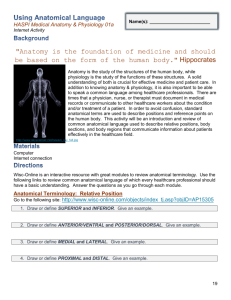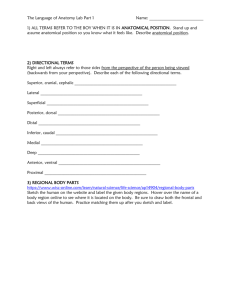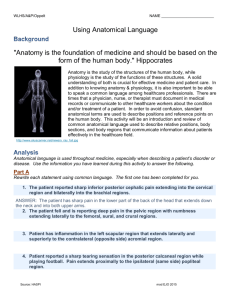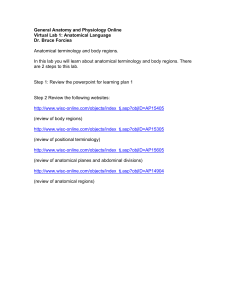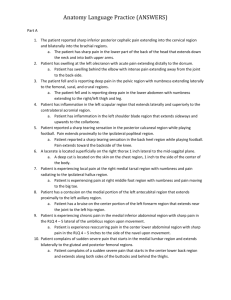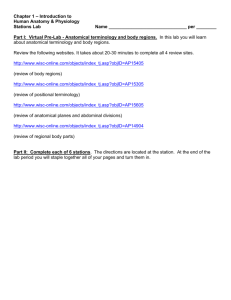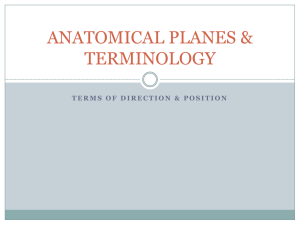Anatomical Language Worksheet: Anatomy & Physiology
advertisement
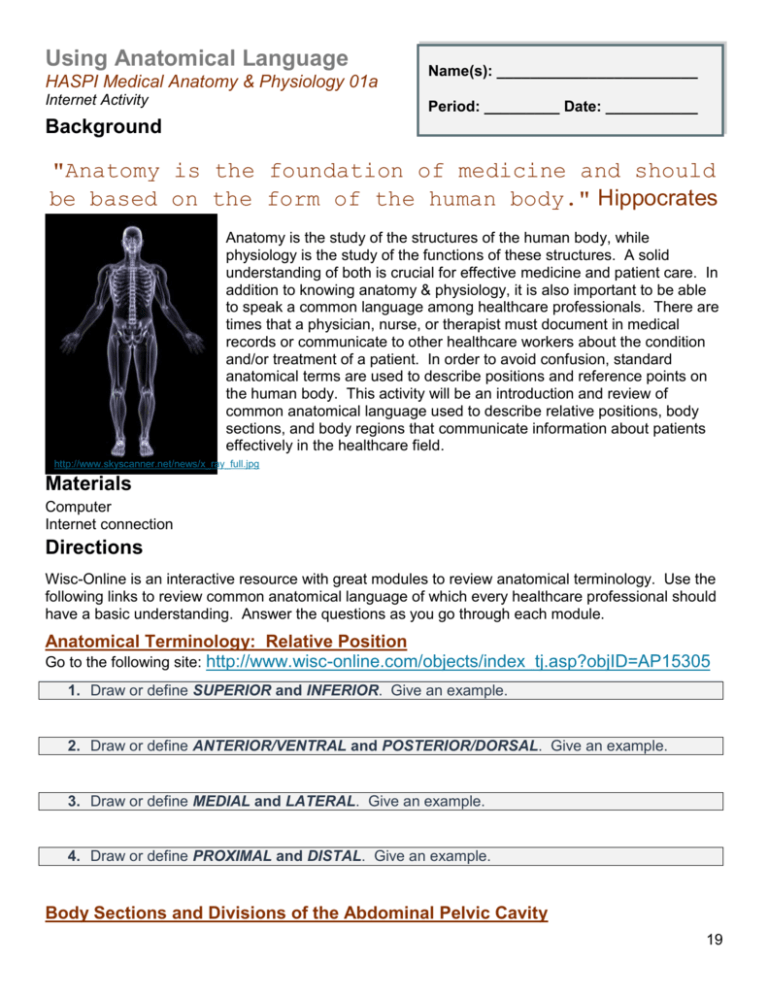
Using Anatomical Language HASPI Medical Anatomy & Physiology 01a Internet Activity Name(s): ________________________ Period: _________ Date: ___________ Background "Anatomy is the foundation of medicine and should be based on the form of the human body." Hippocrates Anatomy is the study of the structures of the human body, while physiology is the study of the functions of these structures. A solid understanding of both is crucial for effective medicine and patient care. In addition to knowing anatomy & physiology, it is also important to be able to speak a common language among healthcare professionals. There are times that a physician, nurse, or therapist must document in medical records or communicate to other healthcare workers about the condition and/or treatment of a patient. In order to avoid confusion, standard anatomical terms are used to describe positions and reference points on the human body. This activity will be an introduction and review of common anatomical language used to describe relative positions, body sections, and body regions that communicate information about patients effectively in the healthcare field. http://www.skyscanner.net/news/x_ray_full.jpg Materials Computer Internet connection Directions Wisc-Online is an interactive resource with great modules to review anatomical terminology. Use the following links to review common anatomical language of which every healthcare professional should have a basic understanding. Answer the questions as you go through each module. Anatomical Terminology: Relative Position Go to the following site: http://www.wisc-online.com/objects/index_tj.asp?objID=AP15305 1. Draw or define SUPERIOR and INFERIOR. Give an example. 2. Draw or define ANTERIOR/VENTRAL and POSTERIOR/DORSAL. Give an example. 3. Draw or define MEDIAL and LATERAL. Give an example. 4. Draw or define PROXIMAL and DISTAL. Give an example. Body Sections and Divisions of the Abdominal Pelvic Cavity 19 Go to the following site: http://www.wisc-online.com/objects/index_tj.asp?objID=AP15605 5. What is the difference between longitudinal, cross, transverse, and horizontal cuts? 6. Draw a SAGITTAL/MEDIAL cut on Figure A below. 7. Draw a CORONAL/FRONTAL cut on Figure B below. 8. Draw a TRANSVERSE/HORIZONTAL cut on Figure C below. Figure A Figure B 9. Label the four QUADRANTS of the abdominal cavity on Figure D. Figure D Regional Body Parts 20 Figure C 10. Label the nine REGIONS of the abdominal cavity on Figure E. Figure E Go to the following site: http://www.wisc-online.com/objects/index_tj.asp?objID=AP14904 Use the “Review-Frontal” and “Review-Back” to label Figure F with the anatomical terms. If it will help, use colored pencils to shade the area for each anatomical term. There are 46 total! Once you have completed the labeling, complete the “Quiz-Frontal” and “Quiz-Back”. Star or highlight any of the anatomical terms that you had a difficult time remembering on Figure F below. Figure F Anatomical Terminology: Body Regions Go to the following site: http://www.wisc-online.com/objects/index_tj.asp?objID=AP15405 Complete all of the drag-and-drop activities as review. Analysis 21 Anatomical language is used throughout medicine, especially when describing a patient’s disorder or disease. Use the information you have learned during this activity to answer the following. Part A Rewrite each statement using common language. The first one has been completed for you. 1. The patient reported sharp inferior posterior cephalic pain extending into the cervical region and bilaterally into the brachial regions. ANSWER: The patient has sharp pain in the lower part of the back of the head that extends down the neck and into both upper arms. 2. Patient has swelling at the left olecranon with acute pain extending distally to the dorsum. 3. The patient fell and is reporting deep pain in the pelvic region with numbness extending laterally to the femoral, sural, and crural regions. 4. Patient has inflammation in the left scapular region that extends laterally and superiorly to the contralateral acromial region. 5. Patient reported a sharp tearing sensation in the posterior calcaneal region while playing football. Pain extends proximally to the ipsilateral popliteal region. 6. A laceration is located superficially on the right thorax 1 inch lateral to the midsagittal plane. 7. Patient is experiencing local pain at the right medial tarsal region with numbness and pain radiating to the ipsilateral hallux region. 8. Patient has a contusion on the medial portion of the left antecubital region that extends proximally to the left axillary region. 9. Patient is experience chronic pain in the medial inferior abdominal region with sharp pain in the RLQ 4-5 inches lateral of the umbilicus region upon movement. 10. Patient complains of sudden severe pain that starts in the medial lumbar region and extends bilaterally to the gluteal and posterior femoral regions. Part B 22 Rewrite each statement using medical terminology. The first one has been completed for you. 11. Pain is located in the right palm and extends into the pinky and index finger. ANSWER: Pain is located in the right palmar and extends into the medial digital region. 12. The patient fell and attempted to stop the fall with the right hand. Patient is now experiencing pain in the right wrist that extends up the right forearm to the elbow. 13. Patient has a headache with pain in the forehead, in between the eyes, and the sinuses. 14. Patient has a cut on the left leg that starts at the outside of the knee, moves over the outside of the thigh, and ends at the left hip bone. 15. Patient is complaining of pain in the lower back that shoots down both sides of the backside and continues down the back of both legs to the knee when bending over. 16. Patient was hit in the face with a basketball during practice and has pain in his nose and right eye that extends to his right cheek and chin. Patient also has a ringing sound in his right ear. 17. The patient landed on the left shoulder and has pain under the left shoulder blade that shoots into the neck and upper part of the spine. 18. Patient dislocated the right thumb and has pain radiating through the forearm to the elbow. 19. Patient is experiencing burning pain under the ribs and center of the chest that radiates into the upper back under both of the shoulder blades upon breathing. 20. Patient has located a large lump in the right breast a few inches to the outside of the nipple along with discomfort and swelling in the right armpit. Part C 23 For each of the following diagrams write a statement in medical terminology describing the location of the pain. The X marks the area of pain, and arrows explain the direction any pain extends. The first one has been completed for you. 21. 22. X X X ANSWER: Pain in the right inguinal region extending down the lateral right femoral to the patellar region. 23. 24. X X 25. 26. X 24 X X X X X
